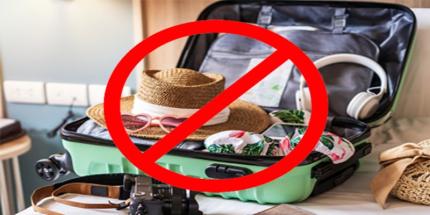Get free consultation
Fill out the form and we will contact you
Traveling or immigrating to the United States is a dream for many Vietnamese, but preparing your carry-on luggage in compliance with regulations is an important factor to ensure a smooth journey. Carry-on baggage rules in the U.S. are strictly regulated by the Transportation Security Administration (TSA) and the airlines. This article provides information on what items are allowed in carry-on luggage when traveling to the U.S.
Carry-on luggage refers to the items you bring into the passenger cabin of the aircraft. According to TSA guidelines and major airlines operating in Vietnam (such as Vietnam Airlines, United Airlines, or Delta), carry-on luggage must comply with the following standards:
Size: Generally no larger than 56 x 36 x 23 cm (including handles and wheels). Some airlines allow an additional small personal item (such as a handbag or laptop backpack) with maximum dimensions of around 40 x 30 x 15 cm.
Quantity: Most airlines permit 1 piece of carry-on luggage plus 1 personal item. Business class or first class passengers may be allowed additional carry-on baggage.
Weight: Typically limited to 7–10 kg, depending on the airline. Low-cost carriers such as Spirit Airlines may enforce stricter checks.
Carry-on luggage refers to the items you bring into the passenger cabin of the airplane
Based on information from TSA and other reliable sources, here is a list of items you can bring in your carry-on luggage when flying to the United States:
Passport, visa, boarding pass, credit cards, cash (it is recommended not to carry more than USD 10,000 to avoid customs declaration).
Laptop, phone, tablet, headphones, power bank (capacity under 100Wh; some airlines allow up to 160Wh with prior approval).
Books, notebooks, pens, and small office supplies.
Liquids, gels, and aerosols (such as toothpaste, hand sanitizer, shampoo) must be in containers of less than 100ml and placed in a transparent plastic bag (maximum capacity of 1 liter). Each passenger is allowed only 1 such bag.
Solid cosmetics (lipstick, foundation, eyeliner) are not subject to volume restrictions.
Medication: Carry prescription drugs in reasonable quantities, along with a doctor’s prescription or medical certificate (translated into English if necessary).
Dry food such as biscuits, snacks, and dried fruit is allowed.
Fresh food (such as fruits and vegetables) is generally prohibited due to U.S. Customs and Border Protection (CBP) quarantine regulations. For example: jackfruit, durian, and other fresh fruits from Vietnam are not permitted.
Prepared food (such as bánh chưng or bánh tét) may be brought if tightly packaged, but must be declared to CBP upon entry. Recent posts on X show that passengers have been fined for failing to declare food brought from Vietnam.
Baby food (formula, puree) is permitted in reasonable quantities but must go through security screening.
Cameras, camcorders, and foldable tripods.
Personal items such as combs, mirrors, tissues, and face masks.
Foldable umbrellas without pointed tips.
Small gifts such as handicrafts, clothing, or souvenirs (avoid sharp objects or items that may be mistaken for weapons, such as toy gun models).
TSA has a strict list of items that are not allowed on board to ensure passenger safety. Below are some of the prohibited items:
TSA’s strict list of prohibited items on airplanes
Sharp objects: Knives, scissors (blades longer than 6 cm), razors, and metal nail clippers.
Liquids exceeding 100ml: Drinks, perfumes, or gels not stored in a 1-liter plastic bag.
Weapons or dangerous items: Firearms (including toys), pepper spray, batons, and multi-tools with blades.
Flammable/explosive substances: Gasoline, lighters, fireworks, and toxic chemicals.
Large lithium batteries: Power banks over 160Wh or batteries without clear labeling of capacity.
Note: Some prohibited carry-on items may be transported in checked baggage, but you must verify specific regulations with your airline and CBP.
When flying to the U.S., you will go through strict security checks both at international airports (such as Tan Son Nhat or Noi Bai) and upon arrival in the U.S. Key points to note:
Carry-on baggage screening: All luggage will be scanned by X-ray machines. If any unclear items are detected, you may be asked to open your bag for inspection.
Liquid screening: Plastic bags containing liquids must be removed from carry-on luggage and placed separately on the screening tray.
Electronics screening: Laptops and tablets must be taken out of their cases and placed separately on trays for scanning.
U.S. customs declaration: Upon entry, you must declare all food, cash (over USD 10,000), and high-value items. CBP may confiscate items or impose fines if you fail to comply.
You will undergo strict security screening at the international airport when flying to the U.S.
Check airline regulations: Each airline has its own rules regarding size and weight limits. For example, Vietnam Airlines allows 7kg, while American Airlines may permit up to 10kg.
Pack light and efficiently: Bring only essential items to avoid exceeding weight or size restrictions.
Back up important documents: Keep digital copies of your passport, visa, and invitation letter (if applicable) on your phone or email.
Prepare for customs inspection: Review the U.S. CBP Declaration Form (Form 6059B) carefully before arrival to avoid mistakes.
Bring light snacks: Long-haul flights (often over 15 hours from Vietnam) can leave you hungry, so carry suitable snacks like crackers or chips for the journey.
Are you preparing for your trip to the U.S. but still unsure about carry-on luggage or entry procedures? Let Quốc Tịch Thứ Hai accompany you! Visit https://quoctichthuhai.com/ for expert advice and comprehensive support, helping you confidently pursue your American dream!
Fill out the form and we will contact you



